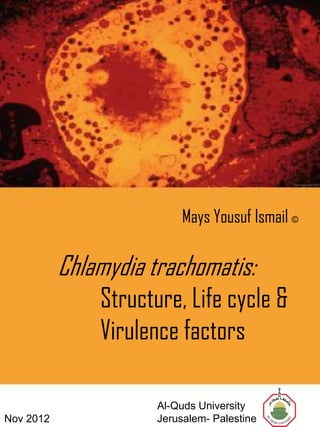
Chlamydia trachomatis
- 1. Mays Yousuf Ismail © Chlamydia trachomatis: Structure, Life cycle & Virulence factors Al-Quds University Nov 2012 Jerusalem- Palestine
- 2. It’s Challenging !! PID:4-5 POVERTY US$10 Million/year billion/year > 500 >6 Million %90 pop. Million @ ECONOMY LIMITEDPOVERTY TO ACCSESS are Blind infected high risk WATER PERSONAL HYGIENE
- 3. Throat infection Trachoma Cervicitis
- 4. What we already know about Chlamydia trachomatis !! Aerobic, obligate intracellular parasite of eukaryotic cells
- 5. Questions raised from this cryptic fact!! 1. Why does it live only intracellularly? 2. Is it really a bacteria? Or a virus? 3. What are its morphology? And its Metabolism pathways? 4. How does it cause disease? 5. What are its weak points? 6. Can we prevent its infection? Can we make a vaccine?
- 6. What makes Chlamydia trachomatis UNIQUE; What makes it CLEVER !! Scientists discovered that Chlamydia trachomatis has a biphasic life cycle Infectious Non-infectious, extracellular intracellular elementary bodies reticulate bodies
- 7. Chlamydia trachomatis biphasic life cycle 3 hrs 7-21 days 30 – 72 hrs 20 hrs
- 8. But what makes EB infectious?? why isn’t it found intracellularly? and What makes RB survive intracellularly? why isn’t it found extracellularly?
- 9. Hmmmm.. Let’s see …!! Elementary Body Reticulate Body Extracellular form Intra-cytoplasmatic form Infectious particle, released Non-infectious particle, never when infected cells rupture. released. With iodine stain, appears as Analogous to a spore cellular inclusions 0.25 to 0.3 μm in diameter 0.6 μm in diameter. No rigid cell wall; still, Presence of rigid cell wall membrane-bound Preserves genome, plasmids, RNA polymerase, All structures are retained and ribosomes. Replication by binary fission, No Replication rate of 2-3 hrs per generation Metabolically inactive Metabolically active Can induce Exo-, and Endo- Can’t induce Exo-, and Endo- cytosis cytosis
- 10. So, now we know we’re not dealing with only one Bacterium it’s TWO in ONE !! And this maybe makes it easier ?!
- 11. **The fact that the Elementary body is found extracellularly, and has a cell wall. ** Chlamydia has a unique cell wall; outer LPS membrane but NO peptidoglycan. Made it possible to use Gram Stain to figure out the bacteria’s Morphology !! Chlamydia trachomatis is a Gram-negative coccobacilli bacteria. **The fact that the Reticulate body is found intracellularly as inclusions. Made it possible to use Giemsa to detect it intracellularly !! Chlamydia trachomatis is as small or smaller than many viruses; 0.25 to 1.5 μm.
- 13. Why does it live only intracellularly?
- 14. Although Chlamydia trachomatis has a Glycolytic pathway, a linked tricarboxylic acid cycle and an electron transport system to produce energy, also Glycogen synthesis pathway. Still, it’s an Energy Parasite; i.e. can’t synthesize sufficient ATP and is host-dependent. (EB RB)
- 15. What makes a bacteria this clever to live inside a cell? Will this protect it from the immune system?
- 16. Those who wanna compete should work harder !! Polymorphic membrane Chlamydial Anomaly transporter unique cell wall cryptic genome plasmid Compete host for LPS lipids Chlamydia Type III secretion trachomatis Sialic acid of mucous apparatus membranes Pathogenicity 15 %75 Adhesion Islands serotypes sub- Antigenic clinical variation
- 17. Virulence Factors 1. Chlamydia has a unique cell wall; outer LPS membrane but NO peptidoglycan. It contains Cystine-rich proteins functionally equivalent to peptidoglycan. This inhibits phagolysosome fusion. 2. Chlamydia genome encodes for peptidoglycan biosynthesis enzymes but PGs aren’t synthesized; Hence, resistance to beta-lactam drugs. Chlamydial anomaly. 3. LPS that causes septic shock. 4. Adhesion to sialic acid receptors on mucous membranes; presence at sites inaccessible to phagocytes, T-cells & B-cells. 5. Antigenic variation resulting in15 known serotypes. 6. 75% of the infections are sub-clinical still infectious though. 7. Pathogenicity Islands coding for needle-like projection type III secretion apparatus that inject proteins directly from the bacteria into the cell cytoplasm and avoid lysosomes. 8. Chlamydia-infested vacuole divert lipids to itself rather than to another compartment of the host cell. 9. Proteins and regulatory factors produced by the cryptic plasmid. Polymorphic outer membrane auto-transporter family of proteins, the putative large cytotoxin, and stress response proteins.
- 18. Scientists: What if the immune system attacks? Chlamydia trachomatis: I’ll get dormant !! This raised the concept of : Chlamydial persistence
- 19. What we know about Chlamydial persistence • Long-term association between Chlamydia and host cell in which it’s viable but culture-negative state.(are detectable but show no growth) • In vitro persistence show altered growth characteristics; enlarged, and pleomorphic RBs that neither undergo binary fission, nor differentiate back to EBs, but still continue to replicate their chromosomes. • Due to failure of secondary differentiation from RB to EB due to gene down regulation. • Induced by penicillin treatment, amino acid starvation, iron deficiency, IFN-γ exposure, monocyte infection, phage infection, continuous culture and altered levels of sex hormones. • Lasts in vitro until removal of the exogenous stressor.
- 20. Aren’t there any gaps ?? 1. Penicillin arrests Bacterial Cytokinesis 2. Tetracycline, Erythromycin block Protein Synthesis 3. Although there’s no immunogenic surface proteins; still, LPS can be used, but they are weak !! (vaccine).
- 21. Be Aware !! Chlamydia trachomatis is present as asymptomatic state within specific hosts providing a natural reservoir.
- 22. ECOLOGY
- 23. References 1.http://en.wikipedia.org/wiki/Chlamydia_(bacterium) 2.http://www.ncbi.nlm.nih.gov/pubmed/10411734 3.http://microbewiki.kenyon.edu/index.php/Chlamydia_trachomatis 4. http://www.biomedcentral.com/1471-2180/11/150 5.http://www.sunysccc.edu/academic/mst/microbes/32ctrac.htm 6.http://www.plosone.org/article/info%3Adoi%2F10.1371%2Fjournal.pone.0007 723 7.http://web.uconn.edu/mcbstaff/graf/Student%20presentations/Chlamydia/Chla mydia%20trachomatis.html 8.http://www.tjclarkdirect.com/bacterial_diseases/chlamydia_trachomatis.htm 9. http://www.austincc.edu/microbio/2421a/ct.htm 10. http://www.ncbi.nlm.nih.gov/pubmed/20470049 11. http://jid.oxfordjournals.org/content/201/Supplement_2/S126.full 12. http://www.hindawi.com/journals/idog/2011/525182/fig2/
